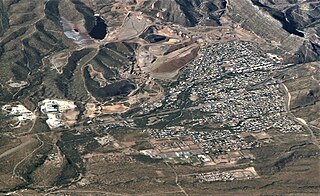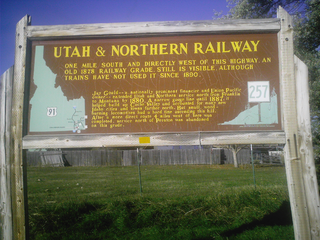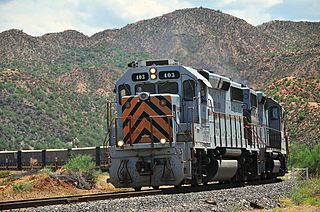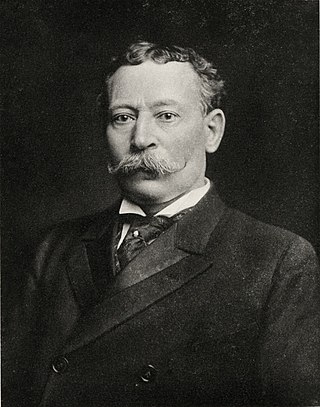
Superior is a town in Pinal County, Arizona. According to the 2020 census, the population of the town is 2,407. Superior was founded as a mining town for the Silver King and the later Magma mines; silver was mined at first, and then transitioned to copper. Currently, exploitation of the huge Resolution Copper deposit is being explored.

Jerome is a town in the Black Hills of Yavapai County in the U.S. state of Arizona. Founded in the late 19th century on Cleopatra Hill overlooking the Verde Valley, Jerome is located more than 5,000 feet (1,500 m) above sea level. It is about 100 miles (160 km) north of Phoenix along State Route 89A between Sedona and Prescott. Supported in its heyday by rich copper mines, it was home to more than 10,000 people in the 1920s. As of the 2010 census, its population was 444. It is now known for its tourist attractions, such as its "ghost town" status and local wineries.

Tooele is a city in Tooele County in the U.S. state of Utah. The population was 35,742 at the 2020 census. It is the county seat of Tooele County. Located approximately 30 minutes southwest of Salt Lake City, Tooele is known for Tooele Army Depot, for its views of the nearby Oquirrh Mountains and the Great Salt Lake.

The Utah & Northern Railway is a defunct railroad that was operated in the Utah Territory and later in the Idaho Territory and Montana Territory in the western United States during the 1870s and 1880s. It was the first railroad in Idaho and in Montana. The line was acquired by a Union Pacific Railroad subsidiary, the Oregon Short Line, and is today operated by the Union Pacific Railroad as the Ogden Subdivision, part of the Pocatello Subdivision, and the Montana Subdivision.

Teck Resources Limited, known as Teck Cominco until late 2008, is a diversified natural resources company headquartered in Vancouver, British Columbia, that is engaged in mining and mineral development, including coal for the steelmaking industry, copper, zinc, and energy. Secondary products include lead, silver, gold, molybdenum, germanium, indium and cadmium. Teck Resources was formed from the amalgamation of Teck and Cominco in 2001.

The Nevada Northern Railway was a railroad in the U.S. state of Nevada, built primarily to reach a major copper producing area in White Pine County, Nevada. The railway, constructed in 1905–06, extended northward about 140 miles (230 km) from Ely to connections with the Western Pacific Railroad at Shafter and Southern Pacific Railroad at Cobre. In 1967 NN reported 40 million net ton-miles of revenue freight on 162 miles (261 km) of line.

The Duluth, South Shore and Atlantic Railway (DSS&A) was an American railroad serving the Upper Peninsula of Michigan and the Lake Superior shoreline of Wisconsin. It provided service from Sault Ste. Marie, Michigan, and St. Ignace, Michigan, westward through Marquette, Michigan, to Superior, Wisconsin, and Duluth, Minnesota. A branchline stretched northward from Nestoria, Michigan, up to the Keweenaw Peninsula and terminating at Houghton, Michigan, with two branches extending further to Calumet, Michigan, and Lake Linden, Michigan.

The Copper Basin Railway is an Arizona short-line railroad that operates from a connection with the Union Pacific Railroad (UP) at Magma to Winkelman, in 54 miles (87 km) of length. The railroad also has a 7-mile (11 km) branch line that runs from Ray Junction to Ray, Arizona. There was formerly an interchange with the San Manuel Arizona Railroad (SMA) at Hayden. The CBRY exists primarily to serve a copper mine. L. S. “Jake” Jacobson was the President and Chief Operating Officer, retiring in 2020 after more than 30 years in his position. In summer 2006, ASARCO Copper Corporation purchased the entire railroad.

La Oroya is a city on the River Mantaro and capital of the Yauli Province, located in the Department of Junin in central Peru. It is situated on the eastern watershed of the Andes at an altitude of 3,745 m, some 176 km east-north-east of the national capital, Lima. La Oroya is the location of a smelting operation that earned the town a place on the Blacksmith Institute's 2007 report on "The World's Worst Polluted Places". It is also the eastern endpoint of the Central Highway of Peru.
Mount Isa Mines Limited ("MIM") operates the Mount Isa copper, lead, zinc and silver mines near Mount Isa, Queensland, Australia as part of the Glencore group of companies. For a brief period in 1980, MIM was Australia's largest company. It has pioneered several significant mining industry innovations, including the Isa Process copper refining technology, the Isasmelt smelting technology, and the IsaMill fine grinding technology, and it also commercialized the Jameson Cell column flotation technology.

Heath Steele Mines, situated 60 km (37 mi) northwest of Newcastle, New Brunswick, Canada, at the headwaters of the Tomogonops and Little Rivers, was a large and productive copper, lead and zinc mine which operated from 1956 to 1999. The mine was an economic cornerstone of Miramichi communities throughout this period.

The California, Shasta and Eastern Railway was a 15 miles (24 km) shortline railroad which operated, for nearly 40 years, between Anderson and Bella Vista, California with no greater aspirations then being a glorified mill spur. Briefly around 1906 however, the road basked in the limelight of the mighty E.H. Harriman who considered, and then discarded, the idea of incorporating it into one of his "paper" railroads projected through the region.

Silver City, Pinos Altos and Mogollon Railroad was a 2 ft narrow gauge railway serving copper mines along the Continental Divide in the mountains of southwestern New Mexico. The communities of Silver City and Pinos Altos developed as 19th century miners recovered easily extracted gold and silver from ore deposits of the area. Standard-gauge Santa Fe Railroad reached Silver City in 1886, and SC, PA&M was incorporated 24 August 1889 to build a railway north to Mogollon, New Mexico. Construction was limited to 5 miles (8.0 km) of grading until Wisconsin-based Comanche Mining and Smelting purchased the railroad and the Pinos Altos mining claims of George Hearst in 1903 after horse-drawn ore transport became uneconomical. The Silver City smelter burned shortly after purchase, but was rebuilt with three blast furnaces and a reverberatory furnace to handle 225 tons of ore per day. Two Shay locomotives were moved to Silver City in August 1905 from the Gilpin tramway of Gilpin County, Colorado. The railroad was built through iron and limestone mines on Chloride Flat west of Silver City. The limestone was used as a flux for smelting the copper ore.
The Kennecott Utah Copper rail line was an electric railroad in Salt Lake County, Utah. It was managed by the Kennecott Utah Copper Corporation and connected the Bingham Canyon Mine with its smelter at Garfield. The rail line has been replaced by a system of conveyors and a 17-mile-long (27 km) slurry pipeline. Current rail operations by Kennecott Utah Copper LLC only occur in the area of the smelter, on a remnant of what was a vast rail network.
Spenceville was a ranching, farming and mining community located in the southwestern part of Nevada County, California, on Spenceville Road just east of Waldo Road, about 17 miles from Grass Valley. Its elevation was about 400 feet. The former townsite is now part of the Spenceville Wildlife Area.

The American Fork Railroad was a 16-mile (26 km) long 3 ft narrow gauge railway from American Fork to Forest City in Utah, which operated from 1872 to 1878.

Joseph Raphael De Lamar was a prominent mine owner and operator in the western United States and Canada, as well as a financier and speculator, from the late 1870s until his death in 1918.
Coronado Railroad was a 20 in railroad which operated in a copper mining region of eastern Arizona.
The Southwestern Railroad is a Class III railroad operating since 1990, and until 2017 consisted of two unconnected railroad sections in New Mexico, with no shared functions. These and a third section in the Texas panhandle and Oklahoma, now closed, all operated separately. Since January 2017, only the Whitewater Division is operated by Southwestern.

The United Verde and Pacific Railway was a 3 ft narrow gauge railroad that operated from 1895 to 1920 in what became Yavapai County in the U.S. state of Arizona. William A. Clark built the 26-mile (42 km) line to link his copper mine and smelter in Jerome to an existing branch of the Santa Fe Railway system. Clark eventually replaced the line with three 4 ft 8+1⁄2 instandard gauge rail lines after building a new smelter and company town in Clarkdale.















